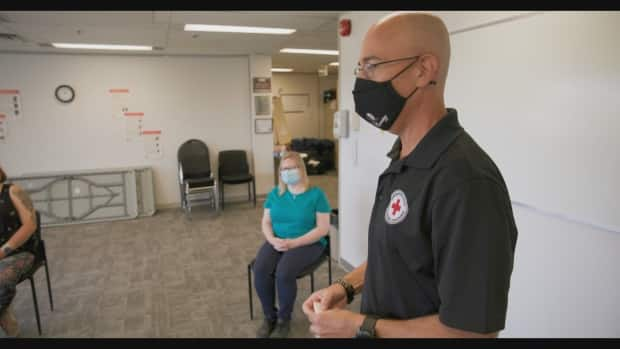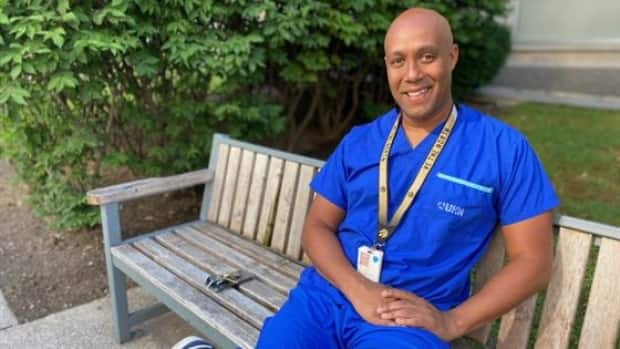Opioid overdose response now part of Red Cross first aid, CPR training as deaths mount

Leigh Chapman smiles as she describes her brother Brad; a father and talented musician who also loved to play hockey and roller blade around Toronto.
"He had a really quirky sense of humour as well," she said.
Brad Chapman, 43, was found dying of an opioid overdose near a downtown Toronto hotel in August 2015. His death led to a coroner's inquest and a series of recommendations for Ontario, Toronto and its police force, which were released in December 2018.
One of the recommendations was to ensure that providers of first aid training in Ontario included opioid overdose response training. More than two and a half years later, those efforts are underway at the Canadian Red Cross.
"I'm really pleased, I think this is long overdue to be honest," Leigh Chapman said.
The Canadian Red Cross has added training to identify and respond to opioid poisoning in all its first aid and cardio-pulmonary resuscitation (CPR) programs across the country. The training is a first in a series of measures funded by Health Canada's Substance Use and Addictions Program to help reduce opioid-related deaths.
According to Public Health Ontario, 2,426 opioid-related deaths occurred in 2020, a 60 per cent rise from 1,517 deaths in 2019. Last year, emergency department visits for opioid overdoses increased nearly 20 per cent in Ontario — from 10,478 visits in 2019 to 12,513.
Experts say the initiative is an important step toward destigmatizing addiction and normalizing naloxone, a medication that temporarily reverses some of the life-threatening effects of opioid poisoning.
As a registered nurse, Chapman was familiar with harm reduction measures but losing a member of her family was a wake-up call.

She says her brother's death "galvanized" her into action.
"How could a 43-year-old father, brother, son, just die in this preventable way?" she said.
Training already underway
Don Marentette, the director of first-aid education and the project lead for opioid harm reduction with the Canadian Red Cross, says the organization recognizes the severity of the opioid poisoning crisis and hopes this training provokes change.
"There's barriers to people accessing naloxone," he said. "So that became a focus. How we can reduce some stigma and normalize the idea of naloxone with everyday Canadians?"
Marentette says the training involves understanding what opioids are, what it could look like if someone was experiencing a poisoning, and learning how to intervene.
He also says there's a focus on reaching under-served communities.
"We know that communities of 50,000-100,000 have twice the rate of opioid deaths than larger urban centres," he said, adding Red Cross is working with the University of Toronto to determine which of them need the most attention.

According to a news release from the Red Cross, it expects "to provide opioid poisoning response training to 1.5 million Canadians over the next three years, while helping millions more to better understand the risks, stigmas, misconceptions, and vulnerabilities of opioid misuse."
It also has plans to add self-directed online opioid poisoning response training in 2022.
Opioid overdoses increased during pandemic
Dr. Hance Clarke, the director of pain services at University Health Network's Toronto General Hospital, says these actions are the culmination of years of research and data.
"The numbers speak for themselves and the deaths continue to go up and even rose sharply during COVID-19," he said, adding their usual advice went out the window when public health measures came into effect.
"Instead of using together, having a community, being around people as you use, [the advice] went to, 'Stay isolated, stay away from people,'" he said.
"You can imagine that isolation can grow pretty deep and you have people in scenarios where they actually can't get that life saving treatment they need."
As an anesthesiologist, Clarke says he recently had his first-aid re-certification and learning the proper steps to administering naloxone was a part of it.
"It's not as straightforward as you would think," he said.

"As an anesthesiologist, I know how to inject medications but until you've held the kit and seen it, you're actually quite surprised that there's vials, you have to draw things up, know where to inject them. So it kind of makes sense it would become part of routine practice."
Clarke hopes to see the results of this training soon.
"One thing's for sure, things like powdered fentanyl and toxicity in recreational drug supply isn't going anywhere anytime soon. The more people who know how to do it, the more likely we are to save their lives."
Meantime, Chapman is relieved to see this progress, but she says there is still work to be done.
"Eventually, it would be great to see naloxone kits everywhere that there is an automated external defibrillator," she said.
She hopes this action signals to the public that this situation is an emergency. She can't help but wonder whether her brother would still be around if this training was implemented earlier.
"Unfortunately, when he needed help the most it wasn't available to him. If this training was included, I think the response might have been quite different."
